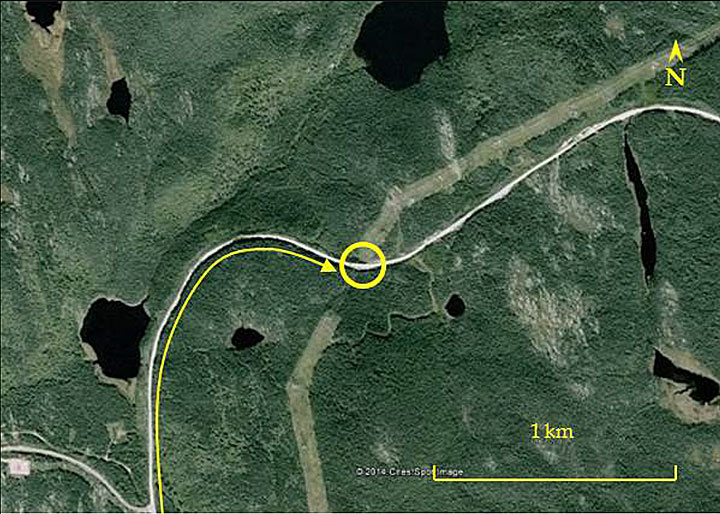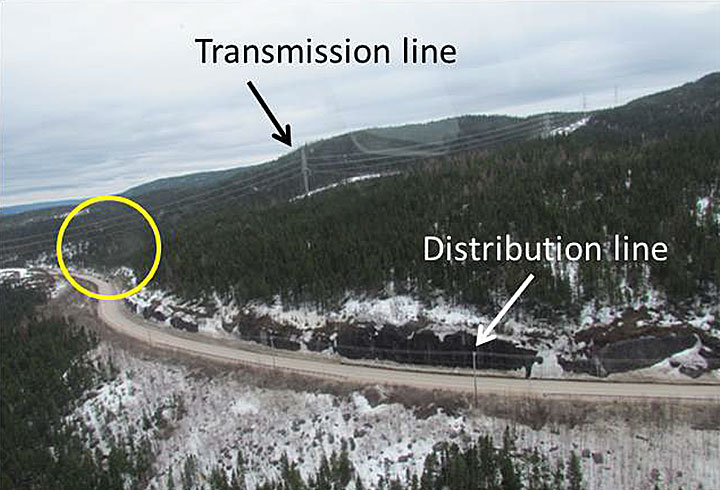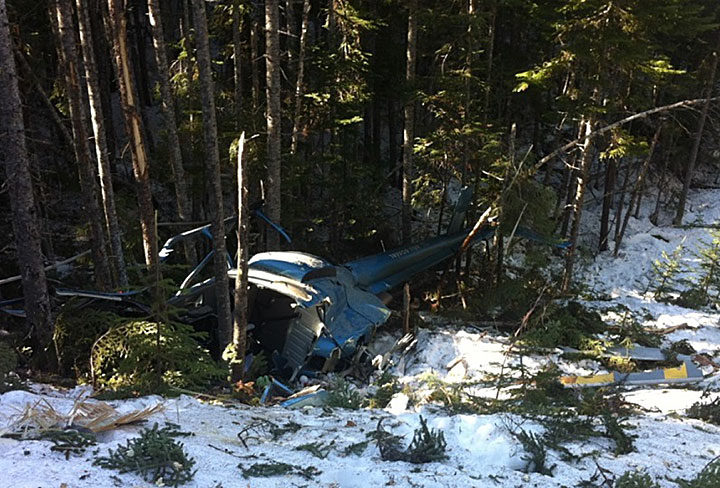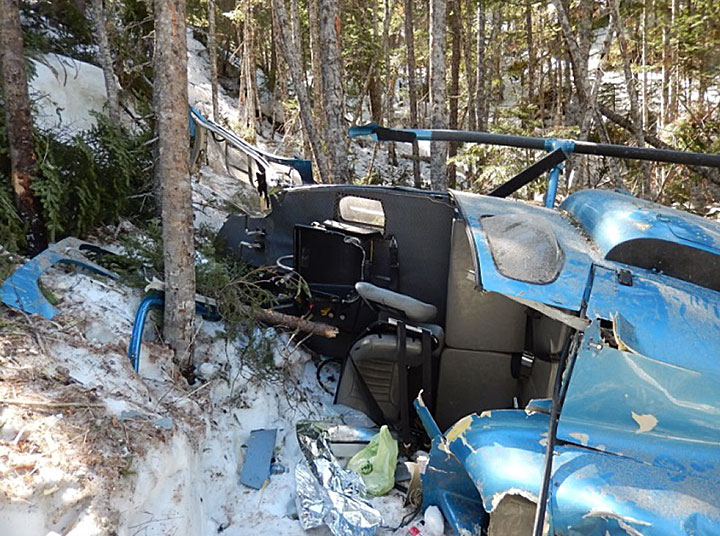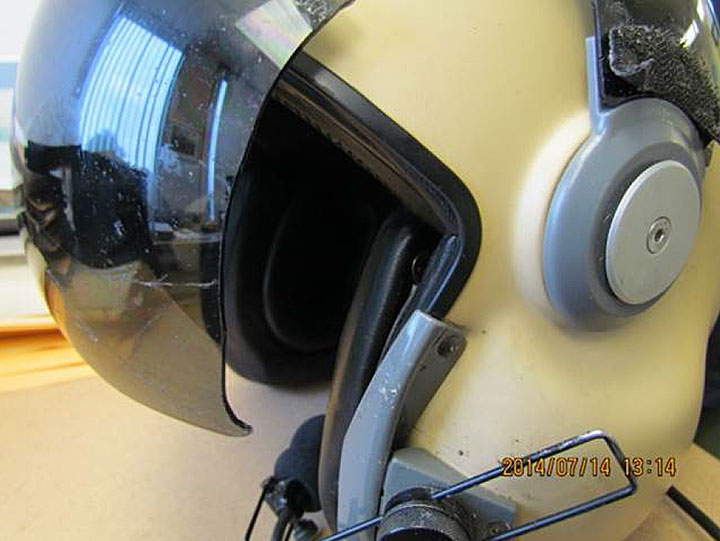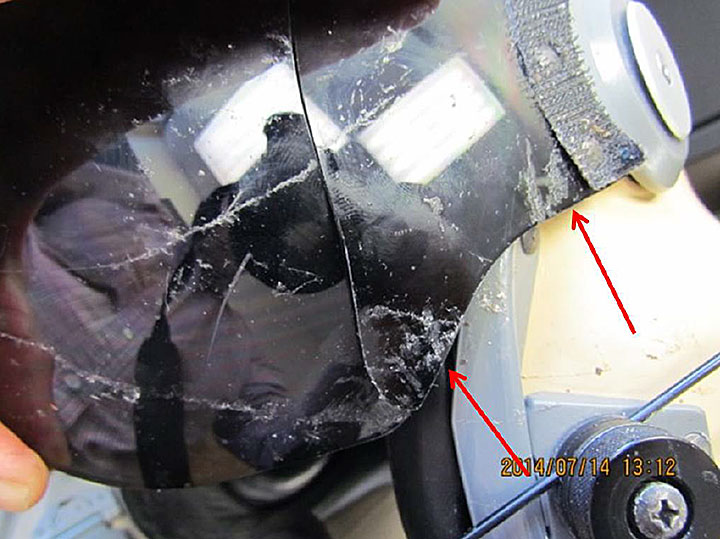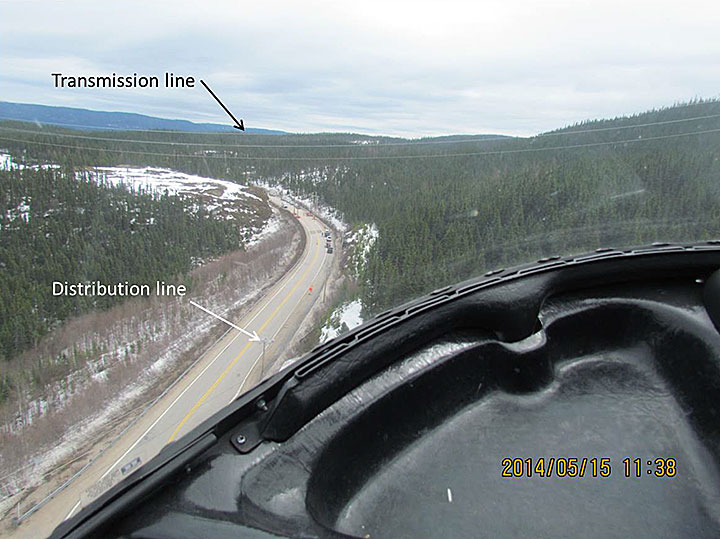Collision with wires
Héli-Boréal inc.
Eurocopter AS 350 BA (Helicopter), C-FHPC
Sept-Îles, Quebec, 35 nm N
The Transportation Safety Board of Canada (TSB) investigated this occurrence for the purpose of advancing transportation safety. It is not the function of the Board to assign fault or determine civil or criminal liability. This report is not created for use in the context of legal, disciplinary or other proceedings. See Ownership and use of content. Masculine pronouns and position titles may be used to signify all genders to comply with the Canadian Transportation Accident Investigation and Safety Board Act (S.C. 1989, c. 3).
Summary
On 13 May 2014, the Héli-Boréal inc. Eurocopter AS 350 BA helicopter (registration C-FHPC, serial number 2395) was on a flight to inspect power-line vegetation encroachment with a pilot and an observer on board. The flight surveyed a 25-kilovolt power distribution line, which ran adjacent to a service road leading to Hydro-Québec’s Sainte-Marguerite power dam. While completing a right turn in a valley, the pilot noticed a 315-kilovolt power transmission line crossing perpendicular to the direction of flight. The right turn was increased to avoid the transmission line, but one of the helicopter’s main rotor blades struck the lower wire. The resulting damage to the rotor blade caused severe vibrations, which made it difficult to control the helicopter. While on approach to land in a small clearing under the 315-kilovolt transmission line, the helicopter’s skid gear contacted trees. The helicopter rolled to the left and fell approximately 50 feet through the trees, coming to rest on its left side in the snow. Both occupants sustained serious injuries, yet were able to exit the aircraft. The helicopter was substantially damaged. The 406-megahertz emergency locator transmitter activated on impact. The Cospas-Sarsat International Satellite System for Search and Rescue did not receive a signal until 25 minutes after the accident. There was no post-impact fire. The accident occurred in daylight hours at 1020 Eastern Daylight Time.
1.0 Factual information
1.1 History of the flight
On 13 May 2014, Héli-Boréal inc. (Héli-Boréal) operated a charter flight for Hydro-Québec using an AS 350 BA helicopter. The objective of the flight was to survey for encroachment of vegetation along a 25-kilovolt (kV) power distribution line in the area of Hydro-Québec's Sainte‑Marguerite (SM3) power plant.
At 0955, Footnote 1 the pilot and an Hydro-Québec employee (observer) departed SM3 to begin the distribution line survey flight. The survey was conducted at an altitude of about 50 feet above ground level along the right side of the road that was adjacent to the distribution line (Figure 1).
While following the distribution line around a hill (arrow, Figure 1), the observer noticed the 315 kV power transmission line Footnote 2 wires that crossed over and above the distribution line ahead. The observer indicated to the pilot that the survey was complete for that section. At that moment, the pilot noticed the transmission line straight ahead, running perpendicular to their flight path (Figure 2). The pilot immediately initiated a right turn to avoid a collision; but 1 main rotor blade hit one of the lower wires of the transmission line, was damaged, and this caused subsequent vibrations in the helicopter. The area under the transmission line was covered with mature trees, with a small cleared path approximately 6 metres wide directly below and parallel to the line. The pilot had limited control of the helicopter and attempted to slow the helicopter for a forced landing along the path. The helicopter's skid impacted the trees just short of the path, and the helicopter rolled to the left, descended into the trees, and came to rest on its left side. The cockpit was destroyed, and the pilot was suspended in the seat above the observer, who was in his seat against the snow-covered ground. The pilot quickly shut down the engine.
Having been able to release both their seat belts, the pilot assisted the observer out of the wreckage. After locating the satellite phone, the pilot moved away from the helicopter to get a satellite signal and contacted Héli-Boréal's base at approximately 1030. The pilot used a thermal blanket located in the helicopter to keep the observer warm. Fifteen minutes later, the pilot proceeded toward the road where an Hydro-Québec vehicle was seen driving by about 150 metres away. The pilot managed to reach the road and met an Hydro-Québec employee who was working nearby. In the meantime, Hydro-Québec rescuers from the SM3 power plant were dispatched to the accident site, where they met the pilot at approximately 1050. Both the pilot and the observer were transported to hospital with serious injuries.
1.2 Injuries to persons
| Crew | Passengers | Others | Total | |
|---|---|---|---|---|
| Fatal | 0 | 0 | 0 | 0 |
| Serious | 1 | 1 | 0 | 2 |
| Minor/None | 0 | 0 | 0 | 0 |
| Total | 1 | 1 | 0 | 2 |
1.3 Damage to aircraft
One of the main rotor blades was significantly damaged when it struck the transmission wire.
The cockpit, instrument panel, radio console, and cabin roof were destroyed during the helicopter's descent through the trees and impact with the ground. All of the rotor blades separated at the main rotor head during the impact with terrain.
The pilot seat back separated, but kept supporting the pilot by the seat belt. The passenger seat broke from the floor seat track attachments. The helicopter was destroyed in the sequence of impact (Photo 1).
1.4 Other damage
Approximately 220 litres of Jet A-1 fuel spilled and were absorbed into the ground around the helicopter.
The lower wire of the transmission line was severed by one of the main rotor blades and fell on the distribution line, which caused a power loss in the electrical distribution system.
1.5 Personnel information
| Pilot-in-command | |
|---|---|
| Licence | Commercial helicopter pilot |
| Medical expiry date | 01 June 2015 |
| Total flying hours (rotary-wing aircraft) | 5847 |
| Hours in the last 90 days | 72 |
| Hours on type | 4454 |
| Hours on duty prior to accident | 2.5 |
| Hours off duty prior to work period | 15 |
The pilot had been Héli-Boréal's chief training pilot since 2010. Footnote 3 Records indicate that the pilot was certified and qualified for the flight in accordance with existing regulations. There was no indication that fatigue, incapacitation, or physiological factors affected the pilot's performance.
1.6 Aircraft information
1.6.1 General
The Eurocopter AS 350 BA is a single-engine, single-pilot, Turbomeca turbine-powered helicopter with 6 seats and a maximum gross weight of 4630 pounds. It has 1 main rotor with 3 blades made of composite material.
Records indicate that the helicopter was certified, equipped, and maintained in accordance with existing regulations and approved procedures, and that there were no known deficiencies before the occurrence flight.
The investigation determined that the helicopter's weight and centre of gravity were within the prescribed limits.
1.6.2 Emergency locator transmitter
The helicopter was equipped with a Kannad model AF-COMPACT, 406-megahertz (MHz) emergency locator transmitter (ELT). The ELT was installed in the right rear baggage compartment, and its antenna was located on top of the main rotor transmission deck.
When activated, a 406 MHz ELT will transmit for a quarter of a second immediately, and then transmit a digital burst once every 50 seconds. The quality and strength of the signal can be affected by objects and antenna position. The Cospas-Sarsat International Satellite System for Search and Rescue (Cospas-Sarsat) Programme is a satellite-based search and rescue distress alert detection and information distribution system. According to its website: Footnote 4
To reach the Cospas-Sarsat satellites the beacon must have a relatively unobstructed view of the sky. A submerged beacon, or one with its antenna blocked by the body of an aircraft or vessel, is unlikely to be received by the satellites. Similarly, it may take longer to detect a beacon activated, for example, in a canyon as there may be a delay before a satellite passes within view overhead.
Examination of the helicopter revealed that the ELT was selected to the ARM position. No damage was noted on the ELT, the antenna, or the connecting wire. The helicopter came to rest with the antenna in the horizontal position. The antenna was shielded by the cowlings and trees. Cospas-Sarsat satellites received an ELT signal 25 minutes after the impact.
1.6.3 Fuel
When the helicopter took off from the Sept-Îles, Quebec, base, it was fuelled to its full capacity of 540 litres. At the time of the accident, there was about 70% (or 370 litres) of fuel left on board, enough for about 2 hours of flying time.
1.7 Meteorological information
The 1000 aviation routine weather report (METAR) for Sept-Îles, about 35 nautical miles (nm) southeast of the accident site, recorded the weather as surface wind 360° True, variable 290° to 030° at 8 knots, and surface visibility 30 statute miles (sm) in clear sky conditions. According to the graphic forecast area, the weather was forecast to be clear sky in the area. The weather was not considered a factor in this occurrence.
1.8 Aids to navigation
The Héli-Boréal company operations manual (COM) requires that pertinent charts be on board. The company used visual flight rules (VFR) navigational charts (VNC). The current VNC applicable for the area was the AIR 5010 Chicoutimi, Edition 14, issued October 2010. The VNC for Chicoutimi was not carried on board during the accident flight, as the pilot was very familiar with the area, nor was it required by regulations.
NAV CANADA publishes the VNCs for Canadian airspace in accordance with International Civil Aviation Organization (ICAO) standard Annex 4. Footnote 5, Footnote 6
ICAO Annex 4, Section 17.7.4, states, “Natural and cultural landmarks, such as bridges, prominent transmission lines […] when considered to be of importance for visual air navigation, should be shown.” Footnote 7
Section 17.9.3.2 states “When considered of importance to visual flight, prominent transmission lines, […] which are obstacles, shall be shown.” Footnote 8
NAV CANADA updates aeronautical information products such as the VNCs using a combination of federal, provincial, private, and commercial data. In 2009, NAV CANADA started digitalizing this information Footnote 9 to enable the use of digital cartography to maintain charts. Cartography is a human process which involves making decisions on the portrayal of information; on occasion, certain features may not be included. This process is governed largely by the purpose of the products being generated. According to ICAO, all structures over 300 feet high are considered obstacles and must be shown on a VNC. NAV CANADA considers that reference to a man-made feature below that limit is for navigation purposes rather than obstacle avoidance. Not all obstacles will be shown, as it is impracticable to guarantee all obstacles have been included, and not all geographical or aeronautical features can be shown.
The VNC AIR 5010 Chicoutimi chart did not show the 315 kV transmission line, even though the transmission line had been in place for more than 15 years. The 315 kV transmission line was less than 300 feet high.
NAV CANADA is the official provider of Canadian VNC data to numerous electronic digital navigation system manufacturers.
NAV CANADA receives obstacle information on a voluntary basis, as it does not have the legal authority to mandate individual parties to provide that information. According to the Canadian Aviation Regulations (CARs) Standard 621, Chapter 1.2, “Any person planning to erect an obstruction should also provide information to Nav Canada, using the ‘Land Use Proposal Submission Form' […].” Footnote 10
Furthermore, any individual who notices a discrepancy in the charts can inform NAV CANADA so that it may be addressed. The investigation noted discrepancies in other VNCs, which were brought to the attention of NAV CANADA and addressed.
Another way that NAV CANADA gathers information is to request data from individual parties, such as Hydro-Québec. The investigation revealed that NAV CANADA had made a few requests to Hydro-Québec for information on transmission lines within the last 3 years with mixed results. As the exchange of information is voluntary, NAV CANADA is limited to making the request.
During the occurrence flight, the observer used a global positioning system (GPS) to record areas where vegetation encroached along power lines. The observer also carried detailed geographical charts that identified Hydro-Québec's infrastructure, including transmission lines and towers. These charts were carried in case of GPS failure. Although aware of these charts, the pilot did not use them for navigation.
1.9 Communications
N/A
1.10 Aerodrome information
N/A
1.11 Flight recorders
The helicopter was not equipped with a flight data recorder or a cockpit voice recorder, nor was either required by regulations.
1.12 Wreckage and impact information
The airframe wreckage was examined, and no indication was found of any pre-accident anomaly or malfunction with the flight controls, the drive train, or other aircraft system that could have contributed to the accident.
The cockpit canopy, doors, instrument panel, instrument console, and windshield were ripped off the cabin and found under the cabin floor.
1.13 Medical and pathological information
N/A
1.14 Fire
There was no post-impact fire.
1.15 Survival aspects
1.15.1 General
The helicopter's cabin roof was ripped off the cabin aft wall and floor structures during the fall. The helicopter was on its left side on the snow-covered ground. Both the pilot and the passenger front seats failed by lateral loads at impact and held occupants in their position.
After falling about 50 feet, the helicopter impacted the frozen ground, with both the pilot and the observer held in their seats by the 4-point safety belt system. The pilot's seat back fractured and separated near the seat base. The observer's seat broke free of the cabin floor in a lateral direction to the left (Photo 2).
The injuries sustained by both occupants were caused by the breakup of the cockpit and cabin roof during the fall through the trees.
1.15.2 Flight helmets
The pilot was wearing a flight helmet, but it came off the pilot's head during the impact.
Examination of the helmet revealed several impact marks visible on the left side and at the top of the helmet. The sun-visor part of the helmet showed 2 severe scratches starting from the left cheek and temple and going toward the left eye and the nose. Photo 3 and Photo 4 show the helmet condition after impact damage. The visor was cracked and scratched by impact loads on its surface. Examination of the helmet chin strap webbing material adjacent to the visor showed severe rubbing marks. However, it could not be determined how the helmet had come off the pilot's head.
The second most-frequently injured area of the body in survivable helicopter crashes is the head. Footnote 11 According to United States military research, the risk of fatal head injuries can be as much as 6 times greater for helicopter occupants not wearing head protection. Footnote 12 The effects of non–fatal head injuries range from momentary confusion and inability to concentrate, to full loss of consciousness. Footnote 13 Incapacitation can compromise a pilot's ability to escape quickly from a helicopter and assist passengers in an emergency evacuation or survival situation.
In 1988, the United States National Transportation Safety Board (NTSB) reviewed 59 emergency medical services (EMS) aviation accidents that occurred between 11 May 1978 and 03 December 1986. This study resulted in NTSB's recommendations A-88-009 to the Federal Aviation Administration (FAA) and A-88-014 to the American Society of Hospital Based Emergency Aeromedical Service asking them to require that flight crew and medical personnel wear protective helmets, and encourage them to do so, to reduce the chance of injury and death.
Transport Canada recognized the safety benefits of using head protection in its 1998 Safety of Air Taxi Operations Task Force (SATOPS) report, in which it committed to implementing the following recommendations:
Recommend Transport Canada continue to promote in the Aviation Safety Vortex Footnote 14 newsletter the safety benefits of helicopter pilots wearing helmets, especially in aerial work operations, and promote flight training units to encourage student pilots to wear helmets. Footnote 15
Safety of Air Taxi Operations Task Force (SATOPS)- Recommendation
In addition, SATOPS directed the following recommendation to air operators:
Recommend that helicopter air operators, especially aerial work operators, encourage their pilots to wear helmets, that commercial helicopter pilots wear helmets and that flight training units encourage student helicopter pilots to wear helmets. Footnote 16
Safety of Air Taxi Operations Task Force (SATOPS)- Recommendation
The TSB has documented a number of occurrences Footnote 17 where the use of head protection likely would have reduced or prevented the injuries sustained by the pilot. There is no regulation requiring helicopter pilots to wear head protection.
TSB Aviation Investigation Report A09A0016 found that despite the well-documented safety benefits and the challenging nature of helicopter flying, the majority of helicopter pilots continue to fly without head protection. Likewise, the investigation found that most Canadian helicopter operators do not actively promote or require the use of head protection by company pilots.
On 27 June 2011, in recognition of the benefits of head protection, a resolution passed by the Helicopter Association of Canada (HAC) Board of Directors stated that:
HAC strongly recommends to its Operator-Members that they should promote the use of helmets for helicopter flight crew members under all operational circumstances which permit their use. HAC also points out, however, that certain pilot/aircraft type configurations may preclude safe helmet use.
At Héli-Boréal, although there is no written company policy for the use of a helmet, approximately 80% of the pilots own and wear them.
1.16 Tests and research
The TSB laboratory was provided with the observer's handheld GPS, which was used to document the region covered. The TSB laboratory downloaded the GPS data for the accident flight, and investigated the time delay between the GPS time of the accident and the time the ELT signal was received at the Canadian Mission Control Centre (CMCC).
The GPS data download indicated the flight track and the position of the accident under the 315 kV transmission power line at 1020:51. The CMCC occurrence ELT case report showed an initial satellite reception at 1045:38, which corresponds to a delay of about 25 minutes with the GPS time. The TSB laboratory concluded that a combination of ELT signal attenuation due to the helicopter location under the forest canopy and data signal degradation due to the antenna being in the horizontal position and shielded under the helicopter cowlings may have resulted in the time delay in decoding the ELT signal by the satellite system.
1.16.1 TSB laboratory reports
The TSB completed the following laboratory report in support of this investigation:
- LP105/2014 – GPS [global positioning system] Analysis
1.17 Organizational and management information
1.17.1 General
Héli-Boréal operates 7 helicopters (6 Eurocopter AS 350 and 1 EC120) and 2 fixed-wing aircraft (Beech King Air 90 and Cessna 206U), and holds a valid Air Operator Certificate. Its base is located about 7 nm northwest of Sept-Îles. The helicopters are operated under Canadian Aviation Regulations (CARs) Subpart 703 - Air Taxi Operations.
The majority of the flights that Héli-Boréal performs are for Hydro-Québec, and are for construction, inspection, and maintenance projects.
Although not yet required by regulations, Héli-Boréal has adopted an in-house safety management system (SMS), in which the president of the company is the accountable executive. Since Héli-Boréal is a small organization, all employees are involved in the discussions of reported unsafe conditions and take action through an informal process. The SMS management team, which consists of the president, chief pilot, director of operations, and director of maintenance, meet formally and informally to address safety issues as topics arise.
In April 2014, a Héli-Boréal helicopter collided with a communication tower guy wire. The company immediately initiated an SMS investigation and implemented corrective action, including additional training on the dangers of low-altitude flying. This training presentation, developed by the chief training pilot (13 May 2014 occurrence pilot), covered the identification of visual cues and markings near power lines and towers, the dangers associated with different phases of flight, the methods to approach power lines, and the importance of remaining vigilant to hazards inherent to low-altitude operations. This presentation was given to all company pilots, and indicated that the occurrence pilot was well informed and trained in the dangers of low-level flying.
1.17.2 Regulatory oversight
Transport Canada (TC) develops and administers policies and regulations for the civil aviation system. Its aviation safety program aims to control the risks at acceptable levels through a systemic approach. The introduction of SMS in the aviation industry is fundamentally changing the way TC approaches its oversight responsibilities.
Traditional surveillance methods have been replaced with assessments and program validation inspections (PVI) Footnote 18 as the primary surveillance tools. Assessments and PVIs are used to measure operational effectiveness and CARs compliance, but the PVI is a routine surveillance method. Footnote 19 TC conducts additional inspections and interventions as needed and based on available resources, including occasional field audits of the operator's aircraft present at the base.
Implemented properly, an SMS allows aviation companies to identify hazards, manage risks, and develop and follow effective safety processes. Canada's large commercial air carriers operating under Subpart 705 of the CARs have been required to have an SMS since 2005. However, for smaller air carriers, such as those that provide aerial work under Subpart 702 of the CARs, provide air taxi services under Subpart 703 of the CARs, or provide commuter services under Subpart 704 of the CARs, SMS implementation has been delayed to provide additional time to refine procedures, guidance material, and training. Yet this group accounted for 92% of commercial aircraft accidents and 95% of commercial aviation fatalities from 2004 to 2013.
In its 2014 Watchlist, the TSB called for TC to implement regulations requiring all operators in the air industry to have formal safety management processes, and for TC to oversee these processes.
Héli-Boréal has an SMS. However, because the SMS is not required by the CARs, its effectiveness has not been verified by TC.
TC performed a PVI of Héli-Boréal in October 2009 to determine the effectiveness of the company's quality assurance system. The PVI was conducted in accordance with TC Staff Instruction SUR-001, Safety Management System Assessment and Program Validation Procedures. The outcome of the PVI revealed no non-compliance with any operational control aspects as all the measurement criteria were met. In December 2010, TC conducted another PVI of Héli-Boréal to determine that the company had a COM, that the COM complied with the regulations, that personnel followed the COM directives, and that the company had a control system process for the COM. The PVI had only 1 finding, concerning the operation and resetting of electric circuit breakers.
1.17.3 Surveillance by frequent users of helicopter services
In general, clients who use commercial helicopter services rely on the operator and on the pilot to ensure flight safety. However, the employer is responsible for the health and safety of its employees and must take reasonable precautions to ensure the workplace is safe. Consequently, some frequent users of helicopter services, including Hydro-Québec, have chosen to implement their own surveillance measures and criteria over and above CARs standards.
1.17.4 Hydro-Québec
Hydro-Québec's Air Transport Unit uses the services of several operators in Quebec to perform aerial work by helicopter. Hydro-Québec has approximately 35 000 kilometres of electrical distribution power lines across Quebec. The annual flight time averages between 11 000 and 15 000 hours, of which approximately 5000 hours are for power line inspections and maintenance. Hydro-Québec is the helicopter services industry's biggest customer in Quebec. In 1992, following a series of accidents, Hydro-Québec set up a qualification and technical audit program to evaluate the helicopter companies it uses and to ensure these companies maintain their aircraft and operations in accordance with the CARs.
In 2005, Hydro-Québec developed a technical assessment method to evaluate its carriers. This method was implemented in collaboration with the École nationale d'aérotechnique (ÉNA), which conducts a quality audit every 18 months on average and produces a report. Hydro-Québec then completes an assessment based on the carrier's past performance and compliance with contractual requirements. The result is expressed as a percentage, which is then used to assign a qualification level to the carrier. Footnote 20 Hydro-Québec indicates the minimum qualification level in calls for tender for helicopter services.
Héli-Boréal underwent a qualification audit on 30 April 2013, obtaining an R1 rating (highest level) with a 100% score. It was the first time in Hydro-Québec's audit of helicopter operators that a perfect grade was given.
1.17.4.1 Flight following
Since Hydro-Québec has a flight following department, Héli-Boréal pilots contracted to fly for Hydro-Québec use that system for flight following. At the time of the accident, the helicopter flight following equipment was being serviced; therefore, the pilot had to call Hydro-Québec flight dispatch once airborne, and then check in at least every 60 minutes. If there was no contact with a helicopter, Hydro-Québec would initiate its emergency procedures.
The occurrence helicopter left the SM3 dam at 0955 and was only on patrol for about 25 minutes prior to the accident. By the time Hydro-Québec would have considered the helicopter overdue and started its emergency procedures, the pilot had already contacted the company to report the accident.
1.17.5 Power line markings
1.17.5.1 General
There is no federal regulatory requirement Footnote 21 to give indication of an upcoming power line crossover as may be encountered during line inspections. However, Hydro-Québec TransÉnergie Footnote 22 has a document of standards Footnote 23 containing a policy to identify the location of power lines and obstacles which aims to optimize and standardize marking installation. The purpose of the markings is to ensure flight safety and to provide individuals performing inspections along the lines with standardized warnings for obstacle avoidance. Markings are mainly installed on flight paths located in rural and forested areas.
According to the document, the crossing of power lines is to be identified by a yellow and black triangular marking Footnote 24 attached to the tower or poles preceding the intersection. Therefore, every intersection is identified by 4 triangular markings, one from each direction. Each triangular marking is positioned to be visible during the flight and pointing in the direction (danger above or below) of the power line that will be encountered. Triangular markings had not been installed at the occurrence intersection. For aviation in Canada, the recognized paint standard Footnote 25 colours are orange and white. Even if this standard is not applicable to the identification of crossing power lines, it provides maximum visibility of an obstruction by contrast colours.
The Hydro-Québec TransÉnergie document mentions that Hydro-Québec employees (observers) must be able to identify the various types of markings in order to warn the pilot, by hand gestures or verbally, of any approaching obstacle. In this occurrence, the observer was aware that the crossing power line was coming up and indicated to the pilot that the inspection was complete. This was communicated at the same time as the pilot saw the wires, and did not provide sufficient warning.
The investigation also revealed that power lines in other areas of the network had some missing and non-compliant markings on approach of crossing power lines.
1.17.5.2 Clearing of vegetation around power lines
Hydro-Québec TransÉnergie has a document identifying the standards Footnote 26 for right-of-way (ROW) Footnote 27 clearings under power lines. It indicates the size of the area to be cleared under power lines, taking into consideration various factors, such as the environmental protection standard, Footnote 28 the reliability of the network, and the safety of the public and workers (i.e. the people involved in maintaining and inspecting the power lines).
The usual ROW clearing covers the whole area under the transmission lines. For areas that are only accessible by helicopter, an extra 26 metres is added to one side of the power line to allow for the safe landing of an helicopter.
The investigation revealed that only a 6-metre-wide area around the short segment of the transmission line on the hillside where the accident occurred was cleared of trees because of the Hydro‑Québec TransÉnergie complementary environmental protection standard established by the Programme de maîtrise intégrée de la végétation (integrated vegetation control programme).
1.18 Additional information
Wire strike accidents are not normally related to a pilot's flying experience. According to the FAA, the average age and experience of pilots involved in such accidents is 43.5 years of age and 4000 flight hours. Footnote 29 As well, the majority (86%) Footnote 30 of such accidents in the United States happened in daytime visual meteorological conditions (VMC).
According to the FAA, the normal field of vision for each eye is about 160° horizontally and 135° vertically. However, outside of a 10° cone of the point of focus, visual acuity drops by 90%. Footnote 31
According to Flight Safety Australia, when discussing fields of vision, “A pilot approaching wires between 2 visible poles would mostly be too far away to discern the wires, or too close to see both the poles at once. Clues within the field of vision would be outside the range of vision and vice versa.” Footnote 32
During the occurrence flight, the helicopter was following a road to the right of the distribution line being surveyed, around a hill. The terrain was up-sloping to the right, with the right-hand tower of the crossing transmission line at a higher altitude than the helicopter (Figure 3).
In addition, many factors can increase the difficulty of seeing wires in the low-level environment:
A pilot's ability to see and avoid collision with wires is complicated by the flood of visual cues seen from a different perspective as low-level work is carried out; by vegetation, shadows and landforms blocking the pilot's view of wires and wire support structures; by cockpit ergonomics; and by seemingly minor things like smudged handprints on the windscreen and insects that speckle the windscreen. Footnote 33
Because of these limitations of human vision, it is important to have other references and visual cues in order to avoid striking wires. It is partly for these reasons that Hydro-Québec implemented standards for markings to help helicopter pilots recognize upcoming obstacles. Furthermore, the clearing of trees under power lines is done to help in building the power lines and performing maintenance. As well, these clearings are used as a visual reference for aircraft performing surveys and patrols. The clearings also provide a safe place to land in case of an emergency.
1.19 Useful or effective investigation techniques
N/A
2.0 Analysis
2.1 General
The examination of the wreckage and components of the aircraft revealed no evidence of any structural failure, flight control malfunction, or loss of power that could have caused the accident. The examination of the maintenance records and maintenance program indicated no issues with the aircraft maintenance that could have contributed to the accident. The investigation of the company regulatory oversight and the safety culture indicated no shortcomings. The company showed a pro-active approach to safety management.
The helicopter took off in good visual meteorological conditions (VMC), and all operational requirements were met for the flight. The analysis will therefore focus on the circumstances surrounding the flight, the power line markings, the clearing under the power lines, the emergency locator transmitter (ELT), the visual flight rules (VFR) navigation chart (VNC) deficiencies, the survivability, and the use of a helmet.
2.2 Power line markings
The pilot was flying low, following a 25- kilovolt power distribution line at an altitude of approximately 50 feet above ground level, close to the tree tops and in valleys. This task required deep concentration. At the time of the occurrence, the flight was following the distribution line around a hill to the right. The crossing 315 kV transmission line came in sight at the end of the turn. In flight conditions such as these, the pilot has narrower peripheral cues than when flying at a higher altitude away from ground obstacles. At the time the observer indicated that the survey was completed for the area, the towers of the crossing power line were likely outside of the pilot's field of vision. There was not enough time to react prior to hitting the wires.
The cues from triangular markings allow pilots to be forewarned of impending hazards. The distribution line being surveyed did not have the standard markings to indicate the upcoming intersection with the transmission line located above it. The investigation revealed that other intersections of power lines throughout the Hydro-Québec network were also lacking the triangular markings. Furthermore, on some of the lines with markings, those markings did not meet Hydro-Québec TransÉnergie's standard as to size and colour. Also, when in place, the yellow and black markings reduce the chances of the markings being seen in a timely manner, compared to markings painted orange and white, which is the recognized paint colour standard in aviation. If power distribution companies do not enforce their power line marking standards, there is an increased risk of collision with wires from low-level flying aircraft.
Hydro-Québec TransÉnergie has established an industry standard to ensure that all crew involved in power line inspection, maintenance, and other work have safety knowledge of the work involved when flying around power lines. An observer can be a great asset in the cockpit as an extra set of eyes. Observers are taught to recognize the markings on towers and poles indicating the impending crossing of power lines. If hazards are not effectively communicated to the pilot in a timely manner, there is an increased risk that a collision with an obstacle may occur, which would jeopardize the safety of the flight.
2.3 Clearing of power lines
Hydro-Québec TransÉnergie has established a standard for clearing trees under and around power lines to allow for their construction and maintenance, and to maintain the reliability of the electrical power distribution system. The clearing of trees is considered essential for the safety of the helicopter flights that must be performed to support the distribution system.
Due to environmental considerations, the short area on the hill under the transmission line was only partially cleared. This condition reduced the opportunity for the pilot to be warned of the presence of the transmission line and it limited the space available to perform an emergency landing.
The helicopter pilot and observer did not receive any of the visual cues normally offered by tree clearings. After impacting the wire, the pilot aimed for the small path under the power line, but hit the bordering trees. If vegetation under power lines is not cleared, there is a risk that low-level survey helicopter flights may not have an adequate landing area in an emergency.
2.4 Emergency locator transmitter
The helicopter came to rest on its left side in a forested area. In order to make a satellite telephone call to the company, the pilot had to move away from the helicopter into a cleared area so that a satellite could receive the telephone's signal. Therefore, it is likely that the emergency locator transmitter (ELT) signal was not immediately received by the satellite because the signal was being shielded by the trees and the helicopter cowlings. If the ELT signal is not received in a timely manner, this could delay rescue operations which risks compromising survivability.
2.5 Navigation charts
In many flight operations, whether in commercial or general aviation, charts are relied upon to assist in identifying potential hazards and navigating accurately. The accuracy of the information provided in the VNC must allow a pilot to safely perform a flight. NAV CANADA is responsible to provide accurate aeronautical data to the user or pilot. Many electronic digital navigation system manufacturers use NAV CANADA's information for their databases. Any erroneous or missing information is therefore propagated throughout the aviation community. The existing request process for obstacle data showed mixed results. If the data collection process to update aeronautical information products does not function effectively, there is a risk that these products may not contain the information required to ensure the safety of flight. If available navigation information is not used, there is a risk that a collision with an obstacle may occur.
2.6 Helmets
The pilot's helmet came off during the impact sequence. The helicopter canopy was no longer protecting the occupants during the fall. The helmet provided sufficient protection to allow the pilot to remain conscious after the impact, to shut down the engine, and to provide help to the observer, who was seriously injured. Examination of the helmet revealed it had sustained a significant impact that would have caused severe injuries to the head and face had the pilot not been wearing it. Not wearing helmets and visors places pilots at greater risk of incapacitation due to head injuries following a ditching or crash. This type of injury jeopardizes a pilot's ability to assist in the safe evacuation and survival of the passengers.
If helicopter pilots do not wear helmets, there is an increased risk of severe injuries, which could affect not only their own survival, but also their ability to assist passengers and to seek help.
3.0 Findings
3.1 Findings as to causes and contributing factors
- The 25-kilovolt distribution line being surveyed did not have the Hydro-Québec TransÉnergie standard triangular markings, which failed to warn of the upcoming intersection with a 315-kilovolt transmission line.
- The helicopter was following the distribution line around a hill and this reduced the opportunity for the pilot to see the upcoming intersection with a 315-kilovolt transmission line in sufficient time to avoid collision.
- A main rotor blade hit a power line wire, which caused vibrations and required the initiation of an emergency landing.
- The trees located under the power line were not cleared; the helicopter hit the trees and fell to the ground.
3.2 Findings as to risk
- If the emergency locator transmitter signal is not received in a timely manner, this could delay rescue operations which risks compromising survivability.
- If the data collection process to update aeronautical information products does not function effectively, there is a risk that these products may not contain the information required to ensure the safety of flight.
- If available navigation information is not used, there is a risk that a collision with an obstacle may occur.
- If helicopter pilots do not wear helmets, there is an increased risk of severe injuries, which could affect not only their own survival, but also their ability to assist passengers and to seek help.
- If power distribution companies do not enforce their power line marking standards, there is an increased risk of collision with wires from low-level flying aircraft.
- If hazards are not effectively communicated to the pilot in a timely manner, there is an increased risk that a collision with an obstacle may occur, which would jeopardize the safety of the flight.
- If vegetation under power lines is not cleared, there is a risk that low-level survey helicopter flights may not have an adequate landing area in an emergency.
3.3 Other findings
- A combination of emergency locator transmitter (ELT) signal attenuation due to the location of the helicopter under the forest canopy and to data signal degradation caused by the antenna being in the horizontal position and shielded under the helicopter cowlings may have resulted in the time delay in decoding the ELT signal by the satellite system.
4.0 Safety action
4.1 Safety action taken
4.1.1 NAV CANADA
NAV CANADA has published a formal fit-for-purpose document (Aeronautical Information Circular 1/15, dated 08 January 2015). The goal of this document is to provide clarity as to the intended use of individual Aeronautical Information Publications (AIP). Use of publications in a manner that does not align with their intended purpose can significantly and negatively impact safety. This document is available on the NAV CANADA website.
NAV CANADA has reached an agreement with Hydro-Québec for the exchange of power line data that may be used as navigational reference on selected charts. In addition, in January 2015, Transport Canada and NAV CANADA exchanged letters confirming nation-wide support for the data acquisition program that will ensure accurate data from authoritative sources.
4.1.2 Héli-Boréal inc.
Héli-Boréal inc. implemented a safety program to provide financial compensation to its pilots for the purchase of flight helmets.
Héli-Boréal inc.'s flight training program has been amended to include flight training improvement techniques for power line inspection flights. The training includes integration of recent study results for visual scanning concepts, pre-flight review of the flight environment, and other tasks in the cockpit that could generate possible distractions. The training also includes flight training for obstacle avoidance.
This report concludes the Transportation Safety Board's investigation into this occurrence. the Board authorized the release of this report on . It was officially released on .
